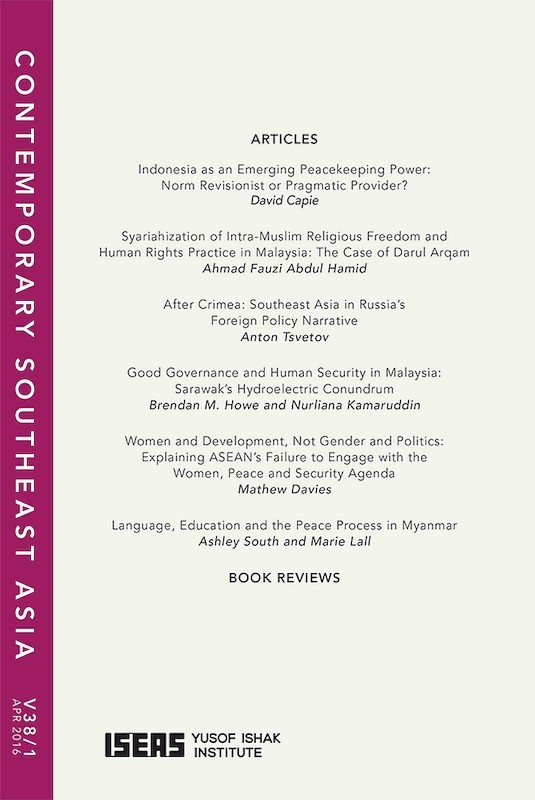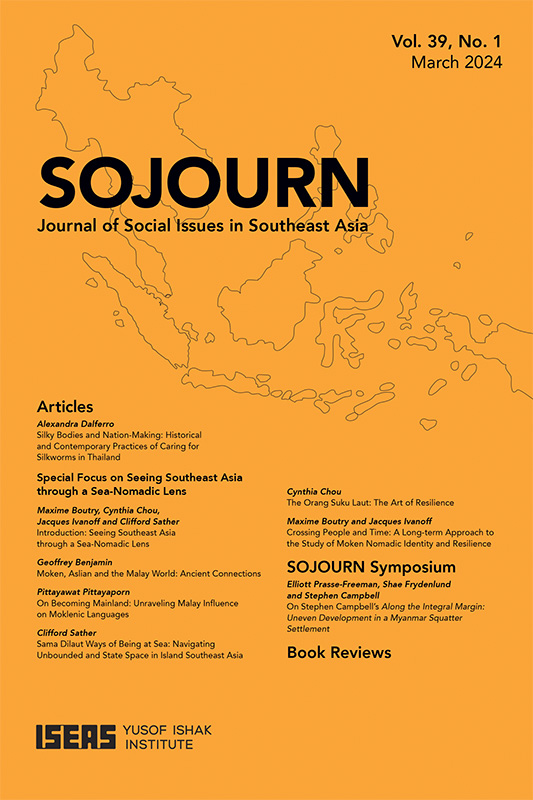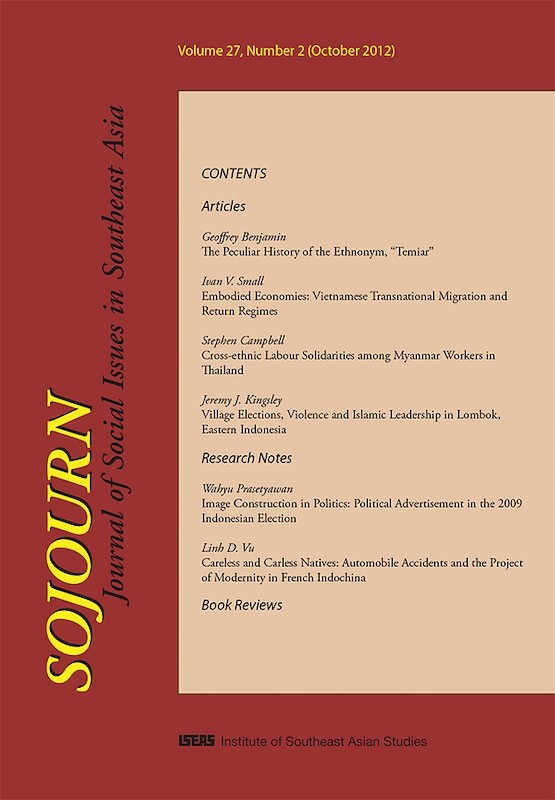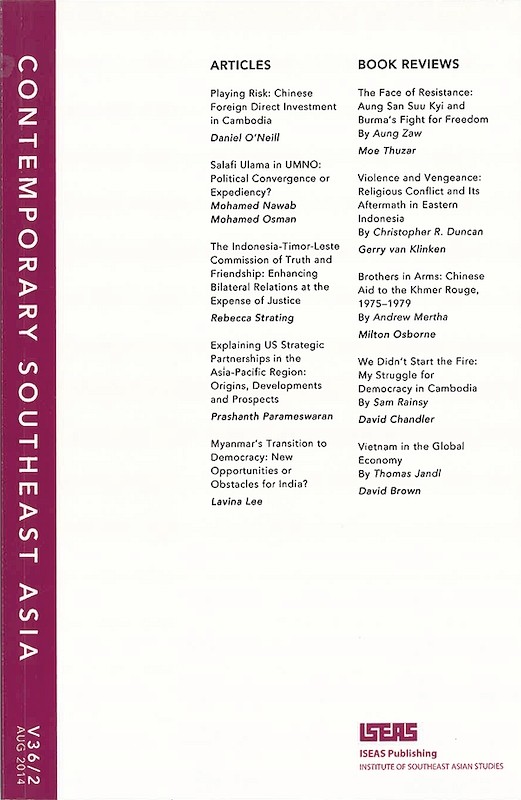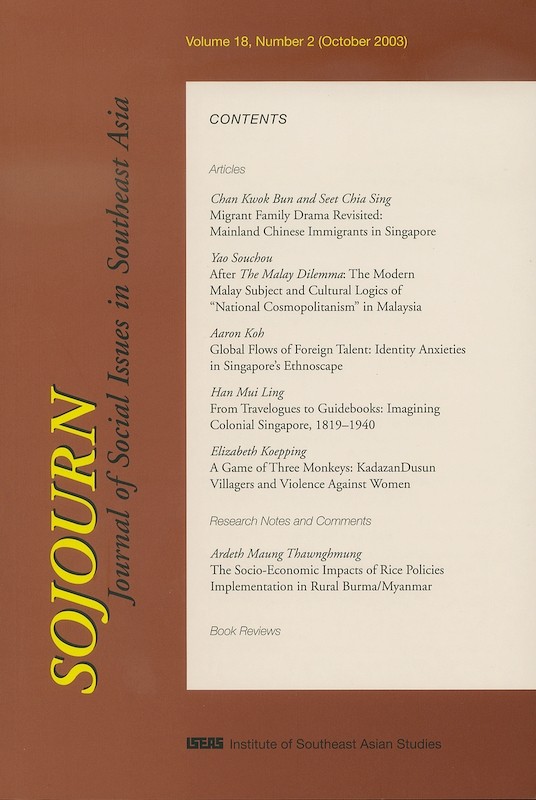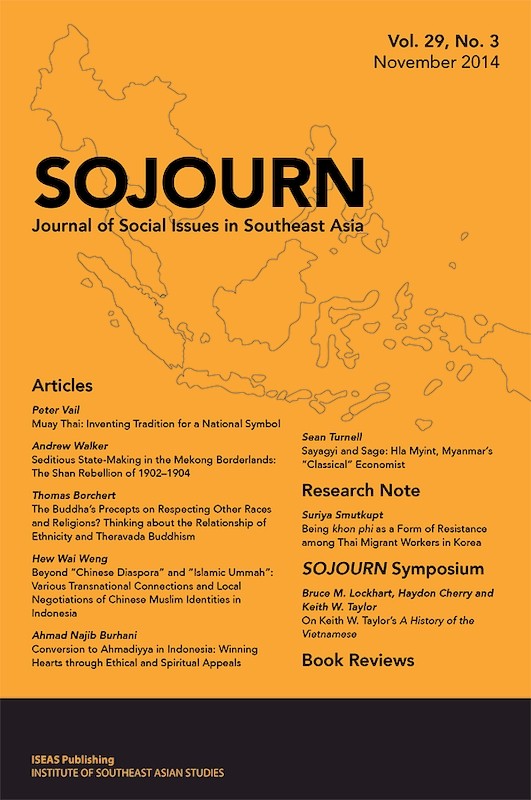SOJOURN: Journal of Social Issues in Southeast Asia Vol. 29/2 (July 2014)
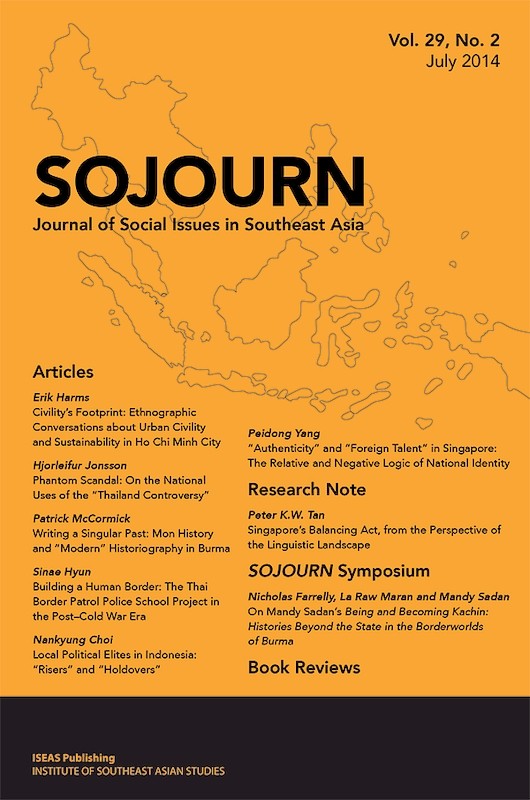
Date of publication:
July 2014
Publisher:
Institute of Southeast Asian Studies
Number of pages:
286
Code:
SJ29/2
Contents
-
SOJOURN: Journal of Social Issues in Southeast Asia Vol. 29/2 (July 2014)
[Whole Publication, ISSN: 17932858] -
Preliminary pages
- ARTICLES
-
Civility's Footprint: Ethnographic Conversations about Urban Civility and Sustainability in Ho Chi Minh City, by Erik Harms, author see abstractVietnamese discourses and practices of “civility” (vaên minh) both intersect and come into conflict with conceptions of urban sustainability. On one level, <i>as ideas</i>, both sustainability and civility are born of the same will to discipline the present-day actions of individuals in order to achieve long-term, future-oriented goals for social collectives. On the level of<i> lived practice</i>, however, the actual lifestyles that accompany contemporary Vietnamese concepts of civility present challenges to<br>sustainable cities. Conversely, many ecologically sustainable urban lifestyles, when viewed through the lens of civility, appear to be socially unsustainable. Ongoing tensions between the concepts of civility and sustainability in Ho Chi Minh City suggest that a nuanced understanding of civility and sustainability in contemporary Vietnamese cities might most productively emerge if one considers the two concepts in dialogue with each other.<br><br>
-
Phantom Scandal: On the National Uses of the "Thailand Controversy", by Hjorleifur Jonsson, author see abstractThe episode known as the “Thailand Controversy” centred on claims that, during the Vietnam War, American anthropologists in Thailand had been collaborating with U.S. and Thai military interests and in ways that harmed social life and efforts towards equality and justice in that country. Reflection and comparison suggest that the allegations of impropriety allowed for emotional identification and understanding in terms of outrage, and that this dynamic is common in the context<br>of anxieties over the transgression of ethnic boundaries. The case is compared with an episode of fears of witchcraft involving the Mien of northern Laos, when an ethnic militia took charge of spiritually and militarily guarding the ethnic boundary. Examination of how the anthropological crisis involving Thailand played out suggests various national differences in the academic discipline, in the United States, Australia, Austria and Thailand. The facts of the case are strongly<br>connected to emotional identification, to a divide in the United States between theoretical and applied anthropology, and to responses to decades of political suppression in the United States.
-
Writing a Singular Past: Mon History and "Modern" Historiography in Burma, by Patrick McCormick, author see abstractThe historiography of the Mons of Burma reflects the larger intellectual world in which Mon scholars have been schooled and trained. Under British colonialism, British scholars introduced a number of ideas and practices related to history. These included ways of viewing and evaluating sources and concepts of ethnicity. Local intellectuals, including Mon scholars, have made these colonial inheritances part of their own historiographical practices. A result is that Mon scholars<br>often project anachronistic readings on to their own past.
-
Building a Human Border: The Thai Border Patrol Police School Project in the Post-Cold War Era, by Sinae Hyun, author see abstractEnjoying royal patronage, the school project of the Border Patrol Police contributed to the construction of a “human border” for Thailand during the Cold War. The project continues to have an impact on current struggles for identity among the country’s highland minorities. Historical and anthropological analysis suggests that the hierarchical integration of the border population into the Thai nation resulted in a tension between the national and ethnic identities of the country’s highland minorities. This tension challenges the sustainability of the modern nation-building effort of the Border Patrol Police and the Thai royal family.
-
Local Political Elites in Indonesia: "Risers" and "Holdovers", by Nankyung Choi, author see abstractLocal political elites in post-Soeharto Indonesia have become increasingly diverse, challenging the dominant characterizations of them as leftovers of the old regime or political opportunists. Existing literature on Indonesia’s local politics tends to focus on top-tier elected officials, such as provincial governors, district regents and municipal mayors. Political elites and elite aspirants at intermediate and lower levels of governance have received less attention. Field-study data collected in Pontianak, the regional capital of West Kalimantan, serves as the basis for analysis of the changing profiles of local elites and elite aspirants and for scrutiny of their efforts and tactics to acquire and retain power. The analysis demonstrates that local political elites in Indonesia consist not only of “holdovers” from the New Order era, but also new and diverse “risers”. “Old” elites remain, as some survived the political transition and as young generations have inherited the resources and constituencies of their forbears. But at the same time “new” elites have entered the local political scene from various socio-economic and cultural backgrounds by taking advantage of new opportunities, resources and strategies. This local political diversification does not, however, necessarily indicate the level of the country’s democratic maturity
-
"Authenticity" and "Foreign Talent" in Singapore: The Relative and Negative Logic of National Identity, by Peidong Yang, author see abstractSingapore’s constitutive sociocultural hybridity has meant that this postcolonial island-nation’s national identity has always been a problematic construct. The developmental state’s pragmatism and self-re-inventiveness further undermine the efforts to construct a stable national identity, frustrating the desire for an authentic nationhood in the essentialist and positive sense. Focus on the more recently arrived “foreign talent” subjects who inhabit the margins of the Singaporean imagination of the national body informs an alternative analytical angle on the question of Singaporean national identity. It is suggested that a sense of national togetherness and belonging emerges through constructing these national Others as “inauthentic”. Examination of two particularly visible and controversial types of “foreign talent” in Singapore — foreign sports professionals and foreign students who have received scholarships from the Singapore government — and of the ways in which they are discursively framed suggests that the “foreign talent” unwittingly constitute a relative and negative solution to Singapore’s national identity problem.
- RESEARCH NOTE
-
Singapore's Balancing Act, from the Perspective of the Linguistic Landscape, by Peter K W Tan, author see abstractMessages displayed or exposed in public spaces have begun to receive attention from scholars, as they turn to the study of what has been referred to as the linguistic landscape or as geosemiotics — if we consider how the text interacts with the social and physical world. Like traditional media, these messages are also public communication, in that the designated audience is the general passer-by rather than specific individuals. In multilingual and multicultural areas of the world, the extent to which different languages are represented in these displays is of particular interest. A distinction is made between official signs, in which the specific languages to be used and even their order might be dictated by by-laws, and unofficial signs erected by individuals or private companies, who have a free hand in deciding what goes on a sign. Singapore has struggled to be even-handed with its official languages (English, Malay, Mandarin Chinese and Tamil), and its linguistic landscape can be seen as evidence of some tension in the balancing act between the official languages. Evidence is drawn from a sampling of data from various key locations in Singapore.
- SOJOURN SYMPOSIUM
-
Being and Becoming Kachin: Histories Beyond the State in the Borderworlds of Burma, by Nicholas Farrelly, La Raw Maran, Mandy Sadan, authors
- BOOK REVIEWS
-
BOOK REVIEW: Interactions with a Violent Past: Reading Post-Conflict Landscapes in Cambodia, Laos, and Vietnam edited by Vatthana Pholsena and Oliver Tappe, by Martin Stuart-Fox, author
-
BOOK REVIEW: Violence and Vengeance: Religious Conflict and its Aftermath in Eastern Indonesia by Christopher R. Duncan, by Shane J Barter, author
-
BOOK REVIEW: Conflict and Conversion: Catholicism in Southeast Asia, 1500-1700 by Tara Alberts, by Michael Pearson, author
-
BOOK REVIEW: Gambling with the Land: The Contemporary Evolution of Southeast Asian Agriculture by Rodolphe De Koninck and Jean-Franois Rousseau, by Michael J Montesano, author
-
BOOK REVIEW: Contemporary Islamic Discourse in the Malay-Indonesian World: Critical Perspectives by Azhar Ibrahim, by Noor Aisha Abdul Rahman, author
-
BOOK REVIEW: Ancestors in Borneo Societies: Death, Transformation and Social Immortality edited by Pascal Couderc and Kenneth Sillander, by Sbastien Penmellen Boret, author
-
BOOK REVIEW: Gender and Islam in Southeast Asia: Women's Rights Movements, Religious Resurgence and Local Traditions edited by Susanne Schrter, by Norshahril Saat, author
-
BOOK REVIEW: Rice Talks: Food and Community in a Vietnamese Town by Nir Avieli, by Najma Rizvi, author

